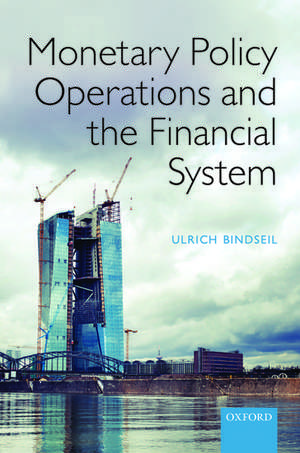Monetary Policy Operations and the Financial System
Autor Ulrich Bindseilen Limba Engleză Hardback – 11 sep 2014
Preț: 507.29 lei
Preț vechi: 599.98 lei
-15% Nou
Puncte Express: 761
Preț estimativ în valută:
97.08€ • 100.98$ • 80.15£
97.08€ • 100.98$ • 80.15£
Carte tipărită la comandă
Livrare economică 04-10 aprilie
Preluare comenzi: 021 569.72.76
Specificații
ISBN-13: 9780198716907
ISBN-10: 0198716907
Pagini: 338
Ilustrații: 101 Figures, 17 Tables
Dimensiuni: 173 x 240 x 26 mm
Greutate: 0.65 kg
Editura: OUP OXFORD
Colecția OUP Oxford
Locul publicării:Oxford, United Kingdom
ISBN-10: 0198716907
Pagini: 338
Ilustrații: 101 Figures, 17 Tables
Dimensiuni: 173 x 240 x 26 mm
Greutate: 0.65 kg
Editura: OUP OXFORD
Colecția OUP Oxford
Locul publicării:Oxford, United Kingdom
Recenzii
The financial crisis and its aftermath have highlighted the importance of understanding how central banks operate, that is, how they use their balance sheets and other tools to implement monetary policy decisions. This book offers a unique and detailed view of the structure, history, and impact of monetary policy operations, both in normal times and in times of crisis. Written by a leading expert and experienced central banker, it is essential reading for policy makers, practitioners, and academics alike.
For a long time, monetary policy operations used to be a rather boring subject. But since 2007, central banks worldwide had to engage in a wide range of unconventional policy measures which are hard to understand and evaluate for non-experts. Written by the person in charge of monetary policy operations at the ECB, this book provides an excellent account of the conduct of monetary policy during times of crises. It introduces the basic theoretical models needed to understand the driving forces behind liquidity crises and outlines adequate policy responses. At the same time, it carefully addresses the risks involved in these measures. The interaction between monetary policy and financial stability being of key relevance for the next decades, this book comes just at the right time. It provides invaluable insights both in the theory and the practice of non-conventional monetary policy.
Any monetary economist, central banker, or central bank watcher should read this. If only a treatise like this had been available when I joined the Monetary Policy Committee of the Bank of England: rigorous, aware of historical and institutional realities, and directly and operationally policy-relevant.
Ulrich Bindseil's book provides a consistent framework to understand central bank action, including the related trade-offs and dilemmas. It is both principle-based and deeply rooted in the ECB experience in the European crisis. It is a must read for central bankers, in sunny and in rainy days.
For a long time, monetary policy operations used to be a rather boring subject. But since 2007, central banks worldwide had to engage in a wide range of unconventional policy measures which are hard to understand and evaluate for non-experts. Written by the person in charge of monetary policy operations at the ECB, this book provides an excellent account of the conduct of monetary policy during times of crises. It introduces the basic theoretical models needed to understand the driving forces behind liquidity crises and outlines adequate policy responses. At the same time, it carefully addresses the risks involved in these measures. The interaction between monetary policy and financial stability being of key relevance for the next decades, this book comes just at the right time. It provides invaluable insights both in the theory and the practice of non-conventional monetary policy.
Any monetary economist, central banker, or central bank watcher should read this. If only a treatise like this had been available when I joined the Monetary Policy Committee of the Bank of England: rigorous, aware of historical and institutional realities, and directly and operationally policy-relevant.
Ulrich Bindseil's book provides a consistent framework to understand central bank action, including the related trade-offs and dilemmas. It is both principle-based and deeply rooted in the ECB experience in the European crisis. It is a must read for central bankers, in sunny and in rainy days.
Notă biografică
After his studies, Ulrich Bindseil joined the Deutsche Bundesbank's economics department in 1994. In 1997, he moved on to the European Monetary Institute and to the European Central bank in 1998. There, he was subsequently responsible for the Liquidity Management Section, the Risk Management Division, and finally for the Directorate General Market Operations (since 2012). He has been a lecturer and visiting professor at the Technical University of Berlin since 2008 and has published in the areas of central bank market operations, risk management, and European governance.












